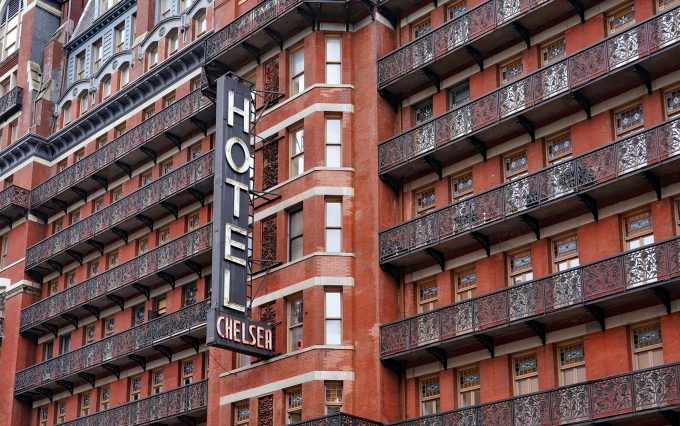
2nd March 2023
Non-Fiction
5 minutes read
The Ballad of The Chelsea Hotel

2nd March 2023
5 minutes read
New York City used to be the most affirmative city in the world. It said “YES” in capital letters, which is why it prompted tens of thousands of weirdos from all over the world to move there every year and become the people they were always meant to be; rock stars, public relations geniuses, painters, photographers, activists, actors, models, drug dealers, movie stars, authors, or professional fuck-ups, like me.
And if they were lucky enough, these shabby new-comers were referred (usually by word-of-mouth) to the World’s Outsider Inn Keeper, Stanley Bard, at the infamous Chelsea Hotel, for a place to stay.
Stanley Bard, the thin host with a quick tongue that was the Gate Keeper for the Playground of the Damned that was “The Hotel Chelsea.” For those of you who have never heard of the Chelsea Hotel,
it’s most famous as the place where Sid Vicious allegedly murdered his girlfriend Nancy Spungen,
a good friend of mine. I used to take showers at Nancy’s apartment because “The Punk Dump,” the office of PUNK magazine, a few blocks away from Nancy’s apartment and the Chelsea, didn’t have a shower.
Even during the height of Punk Rock in New York City, when everything was a target, the desolate Chelsea Hotel still held tons of respect because of its impressive legacy as a home to true artists like Dylan Thomas, Mark Twain, Leonard Cohen, Bob Dylan, Thomas Wolfe, Dennis Hopper, Jack Kerouac, Sherwood Anderson, William Burroughs, Allen Ginsburg, and Arthur Miller after his divorce with Marilyn Monroe. And those are just the writers!
See, the Chelsea was originally conceived as a socialist utopian commune in 1884 by architect Philip Hubert, who was a huge fan of French philosopher Charles Fourier, the man who promoted the idea that people could live harmoniously in a state of nature, free of government intervention.
Unfortunately, the Chelsea’s interior didn’t share the same rosy utopian vision. The current owners describe the place as a decadent palace of peculiarity, but the reality was quite different.
The inside of the hotel resembled a turn-of-the-century lunatic asylum—the slowest elevator in the world,
metal and marble staircases, drab two-tone colored hallways, flophouse rooms—except for the upper floors that housed apartments for permanent residents. Those apartments were wildly opulent spectacles of artistic splendor, depending on the artist who lived there.
Through the decades the Chelsea went from respectable to a junkie haven, as the late Bob Neuwirth (Bob Dylan’s best friend and co-star of “Don’t Look Back”) told an interviewer of the transition that happened in the 1960’s, “That was the period in which the Chelsea Hotel began to take on a tabloid character. It moved from the realm of a bohemian hotel to a kind of hot spot. Rock-and-roll people began to stay there. Andy Warhol and the people who hung out in the back room of Max’s Kansas City were discovering the place…”
Of course,
Andy Warhol was no stranger to the Chelsea,
having shot scenes from his most famous film, “Chelsea Girls” at the hotel. As Warhol assistant Gerard Malanga told Vanity Fair magazine, “Chelsea Girls was one of those divine accidents. When we first started filming, we had no title or concept in mind. We were shooting wildly, you might say. Somehow we found ourselves continually going back to the Chelsea to film. It was our instant set. Andy liked the idea of shooting ‘on location.’ So that’s how the title for the movie pretty much evolved. Not all the sequences were shot there, but structurally when we pieced the sequences together, it gave the appearance that they were shot in different rooms.”
And, of course, Nico, another Chelsea Hotel resident, performed the soundtrack, “Chelsea Girls,” written by the Velvet Underground’s Lou Reed and Sterling Morrison. A better stamp of “official coolness” could not be found. And for the hipsters of the 1970’s, 80’s, 90’s, and 2000’s that stayed at the Chelsea Hotel– the freedom and eccentric living that Stanley Bard tolerated meant no cops banging on the door, unless it was because Andy Warhol superstar, Edie Sedgwick, another hotel guest, set fire to her mattress, again.
A story illustrating how far the Chelsea had fallen by the late 1970’s – Phillippe Marcade, from the punk band, the Senders, told me for my best-selling book Please Kill Me:
“The first time I met Sid Vicious, I was walking on 23rd Street,
because I lived around the corner from the Chelsea, and I was going to a shop to have my broken vacuum cleaner fixed. So I’m walking right in front of the Chelsea and Nancy Spungen came out and yelled, ‘Phillippe!’
So I haven’t seen Nancy since she went to England, so we were like, ‘Hey man, how you been,’ and all that. Then Nancy said, ‘Sid is right behind me, you gotta meet him!’ So Sid comes out, being very Sid Vicious wearing the dog collar and everything, and Nancy said, ‘Sid this is Phillippe, and he’s like my best friend. I told you about him in England!’
FULL VERSION AVAILABLE IN THE PRINT EDITION







